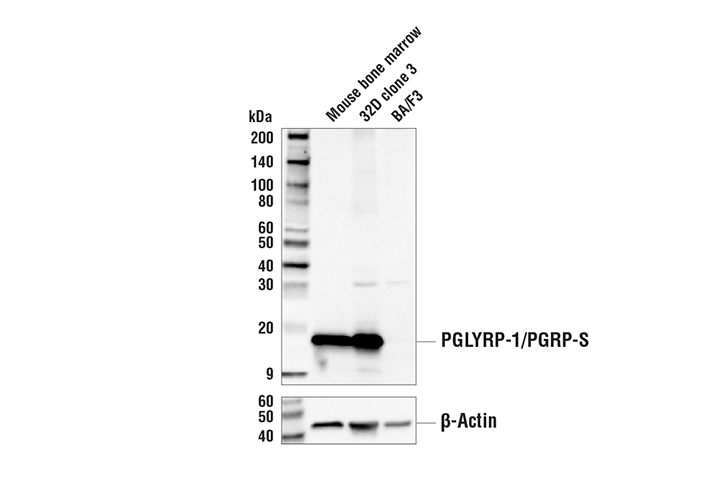WB, IP
M R
Endogenous
18
Rabbit
#O88593
21946
Product Information
Product Usage Information
| Application | Dilution |
|---|---|
| Western Blotting | 1:1000 |
| Immunoprecipitation | 1:50 |
Storage
Specificity / Sensitivity
Species Reactivity:
Mouse, Rat
Source / Purification
Polyclonal antibodies are produced by immunizing animals with a synthetic peptide corresponding to residues surrounding Arg181 of mouse PGLYRP-1/PGRP-S protein.
Background
The human peptidoglycan recognition protein (PGRP) family is composed of four independent genes named for the relative length of their translated product. Human PGRP family proteins are soluble pattern-recognition receptors of the innate immune response that bind peptidoglycan and Gram-positive bacteria, and have direct bactericidal activity (1,2). PGRP-short (PGRP-S), also known as PGLYRP-1 and Tag7, is 196 amino acids (aa) in length (3). PGLYRP-1/PGRP-S is a secreted glycoprotein expressed by neutrophils that participates in killing phagocytized bacteria (4,5). PGLYRP-1/PGRP-S also has been shown to form a stable cytotoxic complex with the heat shock protein Hsp70 to induce tumor cell death (6,7). PGRP-long (PGRP-L), also known as PGLYRP-2, is 576 aa long. PGLYRP-2/PGRP-L is an N-acetylmuramoyl-L-alanine amidase that hydrolyzes bacterial peptidoglycan (8,9). PGRP-intermediate alpha, also known as PGLYRP-3, and PGRP-intermediate beta, also known as PGLYRP-4, are 341 aa and 373 aa long, respectively. PGLYRP-3 and PGLYRP-4 are co-expressed in the same cells and are exclusively secreted as homo- or heterodimers with antibacterial function (10).
- Dziarski, R. and Gupta, D. (2006) Cell Microbiol 8, 1059-69.
- Liu, C. et al. (2001) J Biol Chem 276, 34686-94.
- Kang, D. et al. (1998) Proc Natl Acad Sci U S A 95, 10078-82.
- Liu, C. et al. (2000) J Biol Chem 275, 24490-9.
- Dziarski, R. et al. (2003) Blood 102, 689-97.
- Yashin, D.V. et al. (2015) J Biol Chem 290, 21724-31.
- Yashin, D.V. et al. (2016) Biochimie 123, 32-6.
- Gelius, E. et al. (2003) Biochem Biophys Res Commun 306, 988-94.
- Wang, Z.M. et al. (2003) J Biol Chem 278, 49044-52.
- Lu, X. et al. (2006) J Biol Chem 281, 5895-907.
Species Reactivity
Species reactivity is determined by testing in at least one approved application (e.g., western blot).
Western Blot Buffer
IMPORTANT: For western blots, incubate membrane with diluted primary antibody in 5% w/v BSA, 1X TBS, 0.1% Tween® 20 at 4°C with gentle shaking, overnight.
Applications Key
WB: Western Blotting IP: Immunoprecipitation
Cross-Reactivity Key
H: human M: mouse R: rat Hm: hamster Mk: monkey Vir: virus Mi: mink C: chicken Dm: D. melanogaster X: Xenopus Z: zebrafish B: bovine Dg: dog Pg: pig Sc: S. cerevisiae Ce: C. elegans Hr: horse GP: Guinea Pig Rab: rabbit All: all species expected
Trademarks and Patents
Limited Uses
Except as otherwise expressly agreed in a writing signed by a legally authorized representative of CST, the following terms apply to Products provided by CST, its affiliates or its distributors. Any Customer's terms and conditions that are in addition to, or different from, those contained herein, unless separately accepted in writing by a legally authorized representative of CST, are rejected and are of no force or effect.
Products are labeled with For Research Use Only or a similar labeling statement and have not been approved, cleared, or licensed by the FDA or other regulatory foreign or domestic entity, for any purpose. Customer shall not use any Product for any diagnostic or therapeutic purpose, or otherwise in any manner that conflicts with its labeling statement. Products sold or licensed by CST are provided for Customer as the end-user and solely for research and development uses. Any use of Product for diagnostic, prophylactic or therapeutic purposes, or any purchase of Product for resale (alone or as a component) or other commercial purpose, requires a separate license from CST. Customer shall (a) not sell, license, loan, donate or otherwise transfer or make available any Product to any third party, whether alone or in combination with other materials, or use the Products to manufacture any commercial products, (b) not copy, modify, reverse engineer, decompile, disassemble or otherwise attempt to discover the underlying structure or technology of the Products, or use the Products for the purpose of developing any products or services that would compete with CST products or services, (c) not alter or remove from the Products any trademarks, trade names, logos, patent or copyright notices or markings, (d) use the Products solely in accordance with CST Product Terms of Sale and any applicable documentation, and (e) comply with any license, terms of service or similar agreement with respect to any third party products or services used by Customer in connection with the Products.

